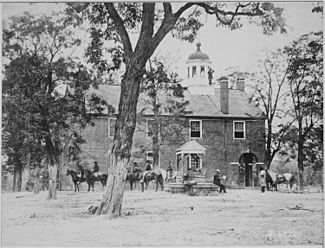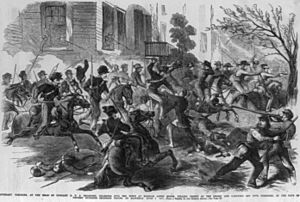Battle of Fairfax Court House (1861) facts for kids
Quick facts for kids Battle of Fairfax Court House |
|||||||
|---|---|---|---|---|---|---|---|
| Part of the American Civil War | |||||||
 Fairfax Court House, Virginia by Matthew Brady From U.S. National Archives |
|||||||
|
|||||||
| Belligerents | |||||||
| Commanders and leaders | |||||||
| Irvin McDowell David Hunter Charles Henry Tompkins |
Milledge Luke Bonham Richard S. Ewell (WIA) John Quincy Marr † William "Extra Billy" Smith |
||||||
| Strength | |||||||
| Between 50 and 86 | Between 40 and 80 engaged | ||||||
| Casualties and losses | |||||||
| 1 killed 4 wounded 3 captured |
1 killed 2 wounded 5 captured |
||||||
The Battle of Fairfax Court House was the first land battle of the American Civil War where soldiers died. It happened on June 1, 1861. A group of Union soldiers were scouting for information. They met a small group of local soldiers from the Confederacy in Fairfax, Virginia.
This fight led to the first deaths in battle. It also marked the first time a high-ranking officer was wounded. The Union soldiers were led by Lieutenant Charles H. Tompkins. They surprised a Confederate rifle company led by Captain John Q. Marr. The Union soldiers took some prisoners.
Captain Marr quickly gathered his unit, but he was killed. A former governor of Virginia, William Smith, then took command. He forced the Union soldiers to leave. The battle did not have a clear winner. The Union did not get the information they wanted. This delay allowed the Confederates to get stronger at Manassas. A much bigger battle happened there the next month.
Why the Battle Happened
Start of the Civil War
The American Civil War began in April 1861. This was after the Battle of Fort Sumter. Fort Sumter was a U.S. Army fort in Charleston, South Carolina. Confederate forces took it over. After this, President Abraham Lincoln asked for 75,000 volunteers. He wanted them to help get back federal property. He also wanted them to stop the rebellion.
Seven states in the southern U.S. had left the Union. They formed the Confederate States of America. Four other southern states, including Virginia, did not want to send troops to fight them. So, Virginia decided to leave the Union too.
Virginia Joins the Confederacy
On April 17, 1861, Virginia leaders met in Richmond, Virginia. They voted to leave the Union. They also allowed the governor to ask for volunteers. These volunteers would join Virginia's military. They would defend the state against the U.S. government.
Virginia Governor John Letcher made Robert E. Lee the commander of Virginia's forces. This happened on April 22. On April 24, Virginia agreed to work with the Confederate States. This meant Virginia's forces would be under the Confederate President. This happened even before Virginia officially joined the Confederacy.
On May 23, the people of Virginia voted. They approved leaving the Union. Governor Letcher officially moved Virginia's forces to the Confederacy on June 6. General Lee followed this order on June 8.
Confederate and Union Forces Gather
By May 31, about 210 Virginia soldiers were in Fairfax Court House. This town was about 13.5 miles (21.7 km) west of Washington, D.C. These soldiers included 120 cavalrymen (soldiers on horseback) and 90 infantrymen (soldiers on foot).
Confederate Lieutenant Colonel Richard S. Ewell was in charge of these soldiers. He had just arrived and did not know his men well. Captain John Q. Marr led the infantry. On the night of May 31, only two guards were watching the road. They did not expect an attack. The Confederate soldiers were in Fairfax Court House to help hide their growing forces at Manassas Junction. This was a railroad hub about 10 miles (16 km) south.
On the same day, Union General David Hunter told Lieutenant Charles Henry Tompkins to find out about Confederate forces. Tompkins was to learn how many there were and where they were located. Hunter's instructions about going into Fairfax Court House were not very clear. But he seemed to want Tompkins to go into the town for information.
Around 10:30 p.m. on May 31, Tompkins led his Union force. It had between 50 and 86 cavalrymen. They left Camp Union at Falls Church, Virginia. Their mission was to scout toward Fairfax Court House.
The Battle Begins
Around 3:00 a.m. on June 1, it was very dark. One of the Confederate guards, Private A. B. Francis, ran into Fairfax Court House. He yelled that the enemy was coming. The other guard had been captured. Some Confederate cavalry tried to get ready to fight. Others ran for their horses.
As the Union soldiers arrived, most of the Confederate cavalry ran away. Four of them were captured. Captain Marr moved his infantrymen into a field near the church. Some fleeing Confederate cavalry rode into them. In the dark, some of Marr's men accidentally shot their own cavalryman. Other Confederate cavalrymen had no weapons or bullets, so they also ran away.
Captain Marr is Killed
Captain Marr asked the riders, "What cavalry is that?" These were likely his last words. Shots were fired as the Union cavalry rode through. Captain Marr fell dead. He was the first Confederate soldier killed in the war.
Some stories say he was looking for a better spot for his men. It was very dark, and no one saw him fall. His body was found later that morning.
The Union soldiers rode west through town, firing randomly. They shot at a man coming out of a hotel. This man was Lieutenant Colonel Ewell. He was wounded in the shoulder. Ewell was the first Confederate officer of his rank to be wounded in the war.
William Smith Takes Command
After the first attack, Captain Marr's infantrymen realized he was gone. Marr was already dead in the field. The company had no leader because its other officers were away.
Then, William "Extra Billy" Smith appeared. He was a former and future governor of Virginia. He was 64 years old and a civilian. He had helped form the company and knew many of the men. So, he took charge, even though he had no military training.
Lieutenant Colonel Ewell soon arrived. But Governor Smith had to tell the men that Ewell was their new commander. Ewell then placed about 40 infantrymen between the hotel and the courthouse. They fired at the Union soldiers as they rode back through town. This forced the Union soldiers to turn around.
The Virginians were not in a good place to defend themselves. After Ewell left to find help, Smith moved the men. They went to a better spot behind some fences. Civilians also joined in the shooting from inside buildings. This might have made Tompkins think there were more enemy soldiers than there actually were.
Union Retreats
The Union soldiers tried to ride through town again. But the Confederate infantrymen forced them back with more shots. Lieutenant Tompkins had two horses shot from under him. One horse fell on him and hurt his foot.
The Confederates kept firing as the Union soldiers tried to leave town. After failing three times to ride through, the Union cavalry had to leave through fields. They took a longer way back to their base.
The Confederates first reported one dead (Captain Marr), two wounded (including Lt. Col. Ewell), and five captured. The Union reported one killed, four wounded (including Lt. Tompkins), and three captured. The Union soldier killed was Private Saintclair. The Union also lost 9 horses killed and 4 wounded.
What Happened Next
Reactions to the Battle
Confederate leaders were upset about the lack of weapons and bullets. This had caused their cavalry to run away. Union General-in-Chief Winfield Scott was unhappy with Tompkins. Scott felt Tompkins had gone too far beyond his orders to just scout. He was also upset that Tompkins talked to reporters before writing his official report.
General McDowell praised Tompkins for being brave. But he also said Tompkins went beyond his orders. He said Tompkins accidentally stopped a "more important movement." He also criticized Tompkins for talking to the press too soon.
The reports from both sides were not fully accurate. Both sides at first made the enemy's numbers seem larger. They also claimed to have caused more damage. Because the war had just started, any battle got a lot of attention.
Importance of the Battle
This battle became less important as bigger battles happened later. But it was still special for several reasons:
- It was the first time a Confederate soldier died in battle.
- It was the first time a high-ranking officer was wounded.
- A Medal of Honor was later given for actions in this first fight.
- The Union failed to find out about the growing Confederate forces at Manassas Junction.
- The Union Army's plans were delayed because of wrong information about Confederate strength.
- It showed what many small fights would be like during the war.
Historian Charles Poland, Jr. said this battle was important. Not because it was the first land battle, but because it was like thousands of other small fights. He also said it was a sign of the bigger First Battle of Bull Run to come.
Medal of Honor and Memorial
In 1893, Charles Henry Tompkins received the Medal of Honor. This was for his bravery at the Battle of Fairfax Court House. It was the first time a Union Army officer received this award for actions in the Civil War. He got it 32 years later. His award said he "Twice charged through the enemy's lines and, taking a carbine from an enlisted man, shot the enemy's captain." However, no other accounts say Tompkins himself shot Captain Marr.
A monument to Captain Marr was put up on June 1, 1904. It is near the courthouse today. It says: "This stone marks the scene of the opening conflict of the war of 1861–1865, when John Q. Marr, captain of the Warrenton Rifles, who was the first soldier killed in action, fell 800 feet south, 46 degrees West of the spot. June 1, 1861. Erected by the Marr Camp, C.V., June 1, 1904."
Weeks later, on July 17, Union forces took over Fairfax Court House. They were moving toward Manassas Junction. The Confederates had left the town. The Union forces then moved to Centreville. They fought the Battle of Blackburn's Ford on July 18. Then came the First Battle of Bull Run on July 21. Fairfax Court House saw several other small battles and raids during the war.
Images for kids
See also
In Spanish: Batalla de Fairfax Court House (junio de 1861) para niños




